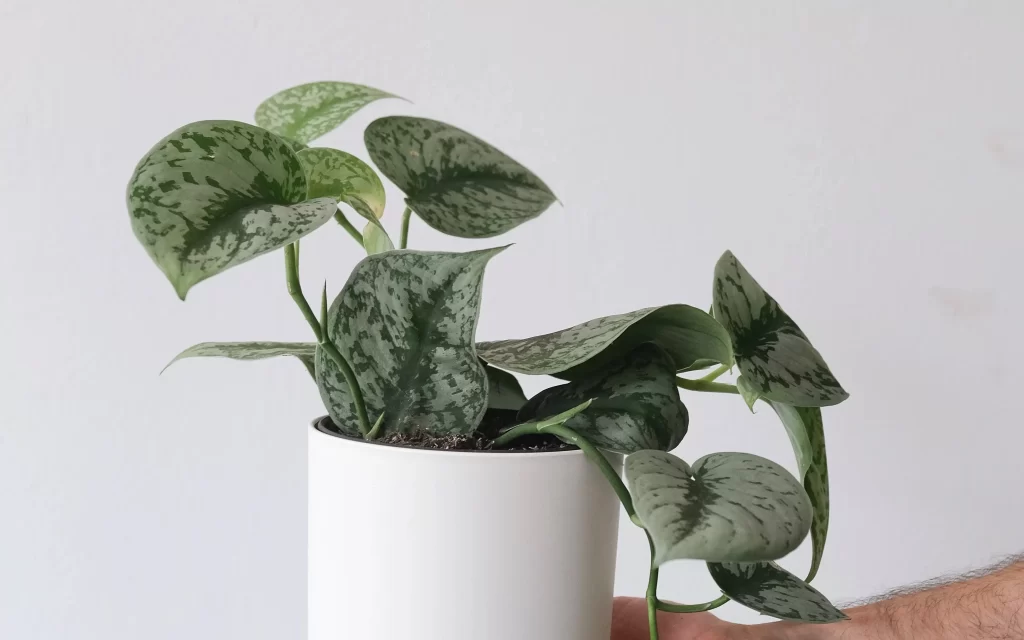Satin silver pothos, botanically known as Scindapsus pictus, is a popular houseplant loved for its soothing dark silver-green texture and uncomplicated care requirements. Its leaves are shaped like hearts and silver variegated, making it look eye-catching. These pothos grow vines that are manageable. You can control how long the vines get by trimming them now and then. However, for best growth, put the plant where it gets gentle, indirect sunlight. But don’t worry if there’s not a lot of light – this plant can handle that too. Additionally, it is an excellent choice for beginners and indoor gardeners due to its low-maintenance nature. It can be a great addition to an interior as it uses hanging baskets and elevated surfaces for trailing vines.

Satin Pothos
The Satin Silver Pothos adds a touch of elegance and uniqueness to the indoor interior, whether allowed to trail down from a hanging pot, climb to support, or be placed on a shelf. However, the appearance of plants can vary based on factors such as light, humidity, and care conditions. Meanwhile, regular observation and appropriate care will help you to maintain the vibrant appearance and wellness of your Satin Pothos.
Features and details
- Botanical Name
- Scindapsus pictus
- Common names
- Silver Satin Pothos
- Geographical origin
- Southeast Asia (Malaysia, Indonesia, Thailand)
- Plant Type and Growth Rate
- Trailing vine (Araceae family) and its growth rate is moderate
- Leaf color features
- Heart-shaped leaves with dark green leaves and silvery-white markings with a pointed tip.
- Light requirements and a temperature range
- Bright indirect daylight; can tolerate low light and the temperature requirement is 65-85°F (18-29°C);
- Watering and Fertilizing
- Allow the inch of soil to dry between waterings and need a balanced liquid fertilizer every 4-6 weeks (diluted).
- Trimming
- Prune the above nodes to encourage bushy growth
- Special considerations
- Protect yourself from direct daylight and temperature extremes (fluctuations)
- Soil Type and Soil pH
- Well-drained potting mix and soil PH is slightly acidic to neutral (PH 6.0 – 7.0).
- Height
- Vines can grow several feet long
- Spacing
- 6-12 inches between plants (for hanging baskets, etc.)
- Air-Purifying Properties:
- a natural air purifier, boosting air quality.
Read: Silver Pothos – Types, Propagation, Care, and Problems
Satin Pothos Leaf Appearance and Features
The Satin Silver Pothos (Scindapsus pictus) exhibits the following leaf appearance and features:
Leaf Appearance:
- Shape: Heart-shaped leaves with a tapering point at the tip.
- Color: Leaves are primarily deep green, with silvery-white markings.
- Texture: Leaves possess a velvety surface and a subtle glossy sheen.
- Vine Growth: Trailing vines that can grow several feet long.
- Leaf Size: Leaves typically range from a few inches to several inches, ranging from 2 to 4 inches in width and 4 to 6 inches in length.
- Leaf Arrangement: The leaves grow alternately along the trailing vines.
Leaf Features:
- Leaf Pattern: Prominent silver-white markings scattered across the leaf surface, creating a speckled or marbled effect.

Propagating Satin Pothos: Methods
Satin Silver Pothos (Scindapsus pictus) can be easily propagated through various methods. Here are the standard ways you can use them:
- Stems cut in water:
- Select a healthy, mature vine with a few nodes.
- Cut a section of the vine just below a node using scissors or shears.
- Place the cutting in a water container (jar), ensuring that at least one node is submerged.
- Keep the container in a well-lit area but out of direct sunlight.
- Change the water every few days to prevent stagnation and promote root growth.
- Once the roots are a few inches long, transplant the cutting into a pot with well-drained soil.
- Stem cutting in the soil:
- Like the water method, select a healthy vine and cut it just below a node.
- Allow the cutting to air dry for a few hours, which helps prevent rot when placed in the soil.
- Plant the cutting into a container (pot) with a well-drained potting mix.
- Keep the soil texture moist but not soggy.
- Place the container (pot) in a sunny location, avoiding direct daylight.
- As the cutting develops roots and new growth, you can re-plant it in a garden area.
Remember to provide appropriate care and attention to the propagated cuttings or layers as they establish roots and acclimate to their new environment. However, patience is vital, as it might take a few weeks to a few months for further growth and sources to develop, depending on the method and conditions.
Common Issues/Pitfalls and Reasons
Satin Pothos (Scindapsus pictus) is a relatively easy-care-for plant, but it can face some common issues and pitfalls like any plant. Here are a few problems you might encounter, along with their potential reasons:
| Common Issues | Potential Reasons | Solutions |
| Yellowing Leaves | Overwatering, poor drainage, inadequate light | Adjust watering, improve drainage, and provide proper light |
| Brown Leaf Tips | Low humidity, dry air, excessive fertilizer | Increase humidity, mist leaves, and avoid over-fertilizing |
| Irregular Growth | Insufficient light | Provide brighter indirect light, prune leggy vines |
| Wilting | Underwatering, root rot, improper drainage | Adjust watering, ensure drainage, and use a well-draining mix |
| Pests | Spider mites, mealybugs, aphids | Regularly inspect, and treat with appropriate measures |
| Lack of Variegation | Insufficient light | Ensure proper lighting for vibrant silverish patterns |
| Yellow spots/browning | Cold or chlorinated water | Use room temperature water. Let tap water dechlorinate |
Read: Does Pothos leave turning yellow? 10+ Reasons and Solutions
Satin Silver Pothos Care Requirements
Light & Temperature Requirements:
Satin pothos thrives in bright, indirect light but tolerates low-light conditions. It is essential to avoid placing the plant in direct daylight as it can affect the leaves. However, a north or east-facing window is ideal for this plant. If the leaves indicate signs of yellow or pale appearance, it may indicate that the plant receives too much light.
- Place your Satin Silver Pothos in bright indirect light, preferably near east-facing windows. You can also position it away from south or west-facing windows to prevent direct sun exposure. The variegation on its leaves suggests it survives in well-lit conditions.
- Satin pothos prefers temperatures between 60-85°F (15-29°C). However, maintain household temperatures above 55°F (13°C) for its well-being.
Ideal placement:
Satin Silver Pothos is an indoor plant that flourishes in various environments. Keep it in a spot with bright light, such as a sunny window, for optimal growth.
Humidity Requirement
Satin pothos prefers humidity levels around 50-60%. If the air in your home is arid, you can increase the humidity by placing the plant on a tray filled with water or using a humidifier.
Watering guidelines
When watering satin pothos, it is essential to strike a balance. It is possible to cause root rot by overwatering, but it is possible to cause leaf wilt and drop by underwatering. However, it would help to wait until the top inch of soil had dried before thoroughly watering the plant. Therefore, it is better to go underwater than underwater Satin Silver Pothos.
- Make sure that the top 0.5 to 1 inch of soil is moist before you water your plant[1]Pothos Plant Care Guide. Read. Avoid consistently moist soil, as Silver Satin Pothos prefers well-drained conditions.
- During watering, ensure that water drains from the bottom of the pot. However, you can water the soil again after it has dried out moderately.
- It can be appropriately revived even if you’ve neglected your plant for a while.
Read: Pothos Watering Guide: Mastering the Art for Thriving Greenery

Fertilizing and Care Tips:
When the growing season (spring and summer) arrives, Satin Silver Pothos will benefit from monthly fertilizer feedings. However, if you dilute the fertilizer to half-strength, use a balanced, water-soluble houseplant fertilizer. Therefore, avoid fertilizing during the severe winter months.
- You should feed your plant half-strength fertilizer every other time you water it during the spring and summer months. In addition to slow-release fertilizers, you can apply them at the beginning of the growing season.
- Encourage new leaf growth by pruning the vines just after a leaf node[2]Satin Silver Pothos Care requirements. Read.
Enhancing Its Presence:
- Hang your Satin Silver Pothos in a basket or place it on a high shelf to showcase its trailing vines.
- Experiment with guiding the vines around the room or twining them around a post to create a lush, jungle-like atmosphere.
The Air-Purifying Benefits of Satin Pothos
Satin Pothos (Scindapsus pictus) goes beyond its aesthetic appeal, offering remarkable air-purifying advantages. Here’s how this charming plant contributes to a healthier indoor environment:
Filtering indoor air:
Satin Silver Pothos actively removes pollutants from the air, such as formaldehyde, benzene, and xylene. However, these compounds commonly eject daily from our household equipment, like refrigerators, microwave ovens, etc.
Enhancing air quality:
As the plant’s leaves capture and process harmful airborne particles, overall air quality improves, promoting a cleaner and fresher atmosphere indoors.

Reducing Stress and Enhancing Well-Being:
Living greenery like Satin Silver Pothos in your home or office space is known to reduce stress and enhance overall well-being due to its green texture. However, a healthier environment contributes to a more pleasant and calming atmosphere.
Care Tips for Maximum Air Purification:
- Place your Satin Pothos in well-lit areas to ensure its active air-purifying processes.
- Maintain a consistent watering routine and proper drainage to keep the plant surviving and efficient in air purification.
- Regularly dust the leaves to prevent accumulation that could hinder their air-purifying capabilities.
By incorporating Satin Pothos into your indoor interior, you not only elevate the visual appeal of your space but also actively contribute to cleaner and more refreshing air, benefiting your health and your surroundings.
Selecting the Right Pot and Soil for Satin Silver Pothos
Considering the right Pot
When considering a pot for your Satin Pothos, prioritize one equipped with drainage holes. Therefore, preventative measure ensures that water doesn’t accumulate at the base, preventing the risk of root rot. However, select a pot slightly larger than the existing root ball – this allows space for growth without overwhelming the plant with excessive soil.
Optimal soil mixture
To boost the success rate of the Satin Pothos, a well-drained potting mix is essential. Combining peat moss with perlite or pumice and high-quality potting soil is an excellent way to establish an appropriate blend. However, it promotes adequate drainage while retaining an optimal moisture level for root health.

Summarization
A satin pothos plant can thrive in various indoor environments thanks to its beautiful appearance and low maintenance requirements. You can enjoy its stunning greenery year-round by providing the right amount of light, water, and humidity. Remember to choose a suitable pot and well-drained soil and fertilize during the growing season. However, with proper care, your Satin Silver Pothos will grow and bring beauty to your home or office interior. Once a week, check if the soil is dry by touching it. If it’s dry, you can give the plant a little water. Moreover, be careful not to add too much water, which can make the plant unhappy. Remember, this plant is easy to care for and adds a touch of nature’s beauty to your interior!



